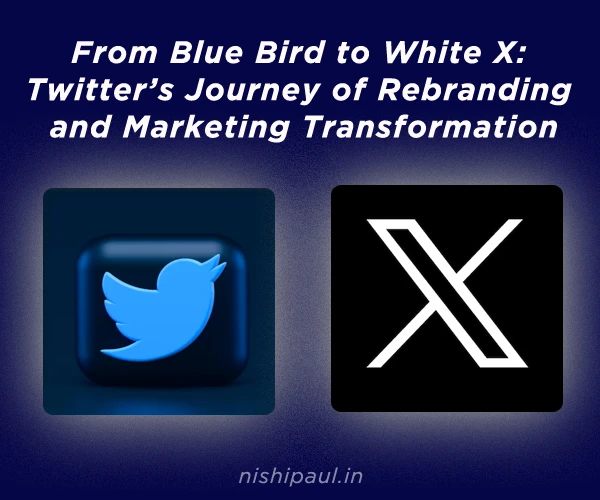Introduction
Twitter, a social media giant known for its iconic blue bird logo, has undergone a significant transformation recently. In this article, we will explore Twitter’s journey from the bluebird to the modern “White X” and the motivations behind its rebranding and marketing shift. This shift has sparked various reactions and conversations within the digital sphere and beyond.
The Evolution of Twitter’s Branding
From Blue Bird to White X
Twitter’s blue bird logo was synonymous with the platform for many years. However, as the company evolved and expanded its services, they decided to embark on a rebranding journey. The old blue bird symbolized simplicity, brevity, and connection, but the new “White X” logo represents a more inclusive, diverse, and dynamic approach.
The Importance of Rebranding
Rebranding is a crucial strategic move for any company looking to stay relevant in a constantly changing market. It allows businesses to communicate their growth, values, and visions effectively. Twitter’s rebranding reflects its commitment to adapt to the ever-evolving digital landscape and cater to the needs of a broader audience.
The Importance of Rebranding
Rebranding is a crucial strategic move for any company looking to stay relevant in a constantly changing market. It allows businesses to communicate their growth, values, and visions effectively. Twitter’s rebranding reflects its commitment to adapt to the ever-evolving digital landscape and cater to the needs of a broader audience.
Twitter’s Marketing Shift
Targeting a Broader Audience
With the rebranding, Twitter aims to attract not only its existing user base but also new demographics. By shedding the association with just microblogging and text-centric content, Twitter seeks to engage a wider audience, including visual content creators, businesses, and influencers.
Enhancing User Experience
Twitter’s marketing shift goes beyond aesthetics. The platform has been actively working on enhancing user experience. This includes introducing new features, improving content curation algorithms, and addressing issues related to harassment and misinformation.
Diversifying Content
In the quest for a broader audience, Twitter now focuses on diversifying its content offerings. This includes promoting more multimedia content such as images, videos, and live streams. Additionally, the platform has been investing in audio-based features and podcasts to tap into the growing audio-centric trend.
The Reactions to Twitter’s Rebranding
User Feedback
Rebranding is a bold move that can elicit mixed reactions from users. Some users embraced the change, seeing it as a sign of progress and innovation. Others, however, expressed nostalgia for the old blue bird and voiced concerns about the potential loss of Twitter’s original identity.
Media and Industry Response
The rebranding was met with significant media attention and discussions within the industry. Marketing experts analyzed Twitter’s strategy, potential impact, and whether it would help the platform stay competitive against other social media platforms.
Twitter’s Strategic Partnerships
Collaborations with Influencers
To promote the rebranding and expand its reach, Twitter engaged in strategic partnerships with influencers from various domains. These influencers not only showcased the new logo but also highlighted the platform’s unique features and content diversity.
Brand Collaborations and Campaigns
Twitter collaborated with brands on marketing campaigns that aligned with the new brand image. This helped create a buzz around the rebranding and attract attention from both users and non-users alike.
Twitter’s Future Outlook
Expanding Global Reach
With the rebranding, Twitter has set its sights on global expansion. The company aims to reach new markets and demographics worldwide, adapting to local preferences and cultural nuances.
Innovating for the Future
Twitter recognizes the need for constant innovation to keep up with the rapidly changing digital landscape. The company continues to invest in research and development to introduce new features and services that align with user expectations.
Conclusion
Twitter’s rebranding journey from the blue bird to the “White X” is a testament to the platform’s commitment to growth, inclusivity, and innovation. By embracing change, targeting a broader audience, enhancing user experience, and diversifying content, Twitter has solidified its position as a versatile and relevant social media platform.
The company’s strategic partnerships, user-centric approach, and future outlook signify a world of opportunities for Twitter and its users. As we move forward, we can expect Twitter to continue shaping the digital landscape and connecting people across the globe.
FAQ’s
Will Twitter bring back the blue bird logo?
As of now, there are no indications of Twitter reverting to the blue bird logo. The “White X” symbolizes Twitter’s new direction and commitment to inclusivity.
How will the “White X” benefit Twitter’s users?
The “White X” represents Twitter’s dedication to diversifying its content offerings and providing a more engaging experience for all users.
What does Twitter hope to achieve through strategic partnerships?
Twitter’s strategic partnerships with influencers and brands help amplify its rebranding message and attract new users to the platform.
Is Twitter planning to add more audio-based features?
Yes, Twitter has been actively exploring audio-based features, such as Spaces, to cater to the rising trend of audio content consumption.
How can businesses leverage Twitter’s rebranding for marketing purposes?
Businesses can align their marketing campaigns with Twitter’s new brand image to reach a broader and more diverse audience on the platform.

